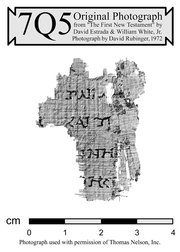7Q5
|
|
Among the Dead Sea scrolls, 7Q5 is the designation for a parchment fragment discovered in Cave 7 of the Qumran community. The significance of this fragment is derived from an argument made by José O’Callaghan in his work “¿Papiros neotestamentarios en la cueva 7 de Qumrân?” in 1972, later reasserted and expanded by German scholar Carsten Peter Thiede in his work The Earliest Gospel Manuscript? in 1982. The assertion is that the previously unidentified 7Q5 is actually a fragment of the Gospel of Mark, chapter 6 verse 52-53. The illustration below gives a clear picture of how much text is conserved on the fragment 7Q5.
Argument
The argument is weighted on two points. First, the spacing before the word ΚΑΙ signifies a paragraph break, which is consistent with the normative layout of Mark in early copies. Secondly, the unique combination of letters ΝΝΗΣ found in line 4 is unique in the extant New Testament Greek lexicon. The only word that contains that specific letter combination is the word ΓΕΝΝΗΣΑΡΕΤ, found only in Mark 6:52-53.
Several counterarguments exist. First, the parchment is so small, and of such poor quality, that positive identification even of the individual letters is difficult at best, Although identifications on similar circumstances such as literature or other subjects have been accepted with not so much discussion. Secondly, there is no consensus that the letters ΝΝΗΣ are the best reading of the parchment. Furthermore, moving outside of Christian writings, the word ΠΕΛΟΠΟΝΝΗΣΟΣ (peloponnesus) is cited as another word in the Greek lexicon containing those four letters. In such case it is possible to consider also the hypothesis that the fragment belongs to a Greek historian. Finally, the assertion that the Qumran community would have access to, and would consider as significant, an early copy of the Gospel of Mark is problematic. The Essenes were an emphatically legalistic group, isolated even from other Jewish sects, although recently it was discovered the “[“Gate of the Essenes”]” in Jerusalem.. The writings of the early church were decidedly libertarian, particularly the section of Mark that immediately follows 6:52-53, wherein Jesus condemns the Jewish religious leaders for their religious legalism.
Significance
It is hard to overstate the significance that a positive identification of 7Q5 as Mark 6:52-53 would have on biblical literary criticism, which may explain both the motivation to see the Gospel of Mark in the fragment and the reticence of many to hang so much on such a small thread. The Qumran community was disbanded no later than 68 CE, which would make that the latest possible date for any documents stored there. This would make 7Q5 the earliest existing fragment of New Testament canonical text, predating P52 by almost 100 years. It would firmly fix Mark as the earliest of the Gospel accounts, and would be a strong argument for authentic Markan authorship, as a pseudonymous work would be highly unlikely within the lifespan of the attested author. Finally, and most significant theologically, it would make a strong argument for the assertion that the miraculous, divine, and messianic attributions to Jesus were very early traditions in the Christian church.
External links
- 7Q5: The Earliest NT Papyrus? (http://www.bible.org/page.asp?page_id=1196)
- 7Q5: Key to the Controversy (http://www.breadofangels.com/7q5/key.html)
- Greek Qumran Fragment 7Q5: Possibilities and Impossibilities (http://www.theologicallycorrect.com/studycenter/modules.php?name=News&file=article&sid=32)
- Jerusalem´s Essenes Gate (http://www.centuryone.org/essene.html)
- 7q5: Cambiar la pregunta (In Spanish) (http://www.monografias.com/trabajos21/cambiar-pregunta/cambiar-pregunta.shtml)

